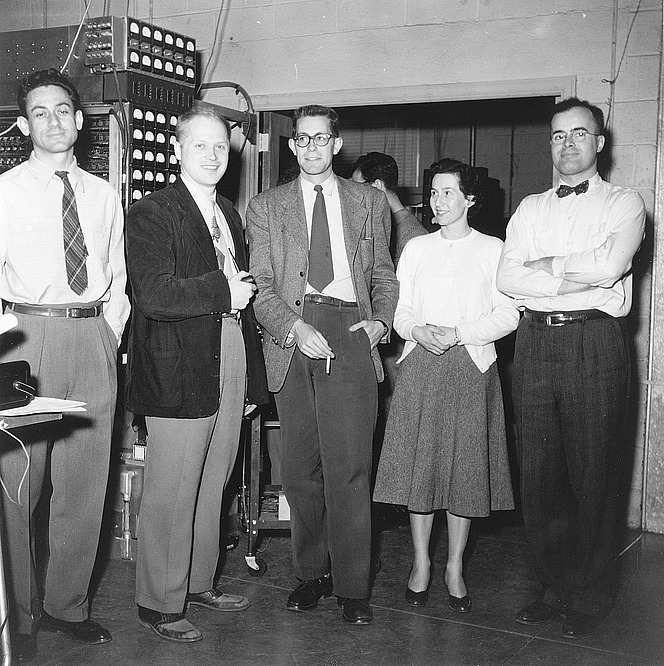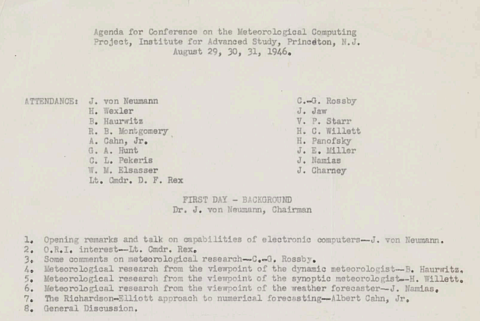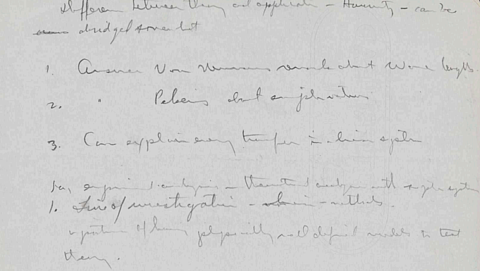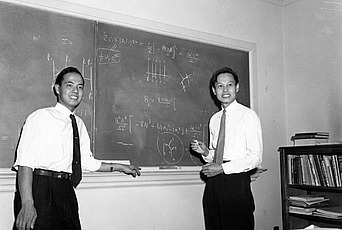
The Politics of Climate Crisis, Then and Now
This year, UPS Foundation Professor Wendy Brown will lead the Institute’s School of Social Science theme seminar on the politics of climate crisis. In her own words, Brown describes the theme seminar as an investigation of the emergent politics that arise “from the crisis’s emergency quality, its global dimensions yet unequally distributed effects, and its severe indictment of existing ways of human life.” In preparation for this historical work, the Shelby White and Leon Levy Archives Center is engaged in a reciprocal effort to uncover the legacy of climate research and climate politics at the Institute.
The Institute’s involvement with the advancement of climatology begins over seventy-five years ago. On August 29, 1946, IAS Professor John von Neumann welcomed a group of sixteen experts in the field of meteorology to the Institute campus. The attendees included two official representatives from the federal government: Lieutenant Commander D. F. Rex of the United States Department of the Navy Office of Research and Inventions, and Harry Wexler, Chief of the Scientific Services Division of the United States Weather Bureau (now the National Weather Service). The United States maintained an active interest in the work of the conference—bringing together a group of meteorologists and mathematicians that might be able to leverage von Neumann’s new Electronic Computer Project to create the first successful numerical predictions to forecast the weather.
Two decades earlier, the first attempts to predict the weather by Lewis Fry Richardson proved unsuccessful. But geopolitical conflict is often the impetus for scientific and technological advancement; the pressures of creating state systems that could effectively predict and leverage meteorological and climate data heightened at the outset of World War II. Beginning with United States involvement in the war, von Neumann and many of the meteorologists attending the conference had been involved in efforts to resolve what the United States saw as a gap in the resources of the Allied powers. In 1940, President Franklin D. Roosevelt called for the construction of 50,000 military aircraft and 10,000 meteorology-trained officers. Suddenly, meteorologists had become a key part of the politics of warcraft.

Von Neumann himself had already joined the effort to combat the Nazi government—whose rise had pushed him to immigrate to the United States from his native Europe and settle at the Institute for Advanced Study—and his work on the Manhattan Project had fueled an interest in the mathe matical problems of weather prediction and control. For von Neumann, the Electronic Computer Project provided the necessary government funding and calculation power to address many of the problems of Richardson’s first attempts.
The list of participants and consultants for the three-day conference included mathematicians and meteorologists of global renown, including the following:
- BERNHARD HAURWITZ, a University of Göttingen specialist in atmospheric and ocean dynamics, then based out of the Massachusetts Institute of Technology (MIT)
- RAYMOND B. MONTGOMERY, former physical oceanographer employed by the Woods Hole Oceanic Institute, then based out of MIT
- ALBERT CAHN, JR., a junior physicist at the University of Chicago’s Metallurgic Laboratory who was involved with von Neumann on the Manhattan Project
- GILBERT A. HUNT, one of the forecasters who had been responsible for weather prediction in advance of the Allied invasion of Normandy on D-Day
- CHAIM l. PEKERIS, an Israeli-American geophysicist and mathematician who left MIT to join the Hudson Laboratories of Columbia University for the duration of World War II
- WALTRER M. ELSASSER, the German-born American physicist known for developing the geodynamo theory presently used to explain Earth’s magnetic fields
- CARL-GUSTAF ROSSBY, a Swedish-born American meteorologist who organized the training of military meteorologists at the University of Chicago and first explained the fluid mechanics of the Earth’s atmosphere
- JEUNG JANG JAW, a pioneering Chinese meteorologist and physicist now known as the father of China’s satellite program
- VICTOR P. STARR, American meteorologist and professor at MIT known for his contributions to atmospheric science
- HURD CURTIS WILLETT, an American meteorologist who headed the development of the polar front theory of five-day weather prediction for the U.S. Weather Bureau
- HANS PANOFSKY, son of Erwin Panofsky and one of the first meteorologists to study the structure of the lowest 300 feet of atmosphere for such purposes as learning how pollutants could be controlled
- J. E. MILLER, the meteorologist and researcher known for his creation of the Miller Techniques used to classify nor’easters
- J. NAMIAS, Chief of the Extended Forecast Division of the U.S. Weather Bureau and one of the meteorologists responsible for weather forecasting in Northern Africa for the Allies during World War II
- JULE G. CHARNEY, American meteorologist credited with the 1979 “Charney Report” of the National Research Council, which documents some of the first scientific assessments on the relationship between carbon dioxide and climate change.

The conference generated work that would lay the foundation for an understanding of climatology that is only becoming familiar to most individuals now, over seventy- five years later. The Meteorology Project that proceeded from the conference not only succeeded in developing the first short-term numerical predictions of the weather, it also brought together some of the most important meteorologists to work on the development of an atmospheric approach to understanding the climate. Under the influence of co-chair Carl-Gustaf Rossby, later workers on the project would develop a sophisticated understanding of the climate as a geofluid dynamic system, a mathematical calculation that could account for the impacts of the ocean and the atmosphere on the weather as global phenomena. These later workers, like Joseph Smagorinsky and Jules Charney (noted above), would leverage this experience to re-conceptualize the study of the weather as the study of the global climate— as exemplified in the 1979 report that bears Charney’s name.
Following the project in 1953, von Neumann published in Fortune magazine, for the American public, an article that confronted the progress and politics of the research. In his essay titled “Can We Survive Technology,” von Neumann predicted the political effects of meteorological interventions, comparing the human manipulation of weather to a kind of biological weapon of the state. Two years later, a separate conference reconvened the various members to discuss the success of the first weather forecasts made at the Institute, and within a few short years, former member of the Meteorology Project Joseph Smagorinsky went on to found the Geophysical Fluid Dynamics Laboratory that remains in Princeton, NJ. Today, the legacy of this work is all around us, and the material evidence remains a treasure of the Shelby White and Leon Levy Archives Center.
